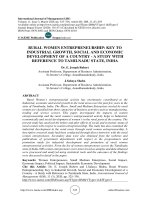Economic growth and economic development 357
Bạn đang xem bản rút gọn của tài liệu. Xem và tải ngay bản đầy đủ của tài liệu tại đây (95.2 KB, 1 trang )
Introduction to Modern Economic Growth
above, a natural conjecture might be that, as in the finite-horizon case, the transversality condition should be similar to that in Theorem 7.1, with t1 replaced with the
limit of t → ∞, that is, limt→∞ λ (t) = 0. The following example, which is very
close to the original Ramsey model, illustrates that this is not the case; without further assumptions, the valid transversality condition is given by the weaker condition
(7.39).
Example 7.2. Consider the following problem:
Z ∞
[log (c (t)) − log c∗ ] dt
max
0
subject to
k˙ (t) = [k (t)]α − c (t) − δk (t)
k (0) = 1
and
lim k (t) ≥ 0
t→∞
where c∗ ≡ [k∗ ]α − δk∗ and k∗ ≡ (α/δ)1/(1−α) . In other words, c∗ is the maximum
level of consumption that can be achieved in the steady state of this model and k∗
is the corresponding steady-state level of capital. This way of writing the objective
function makes sure that the integral converges and takes a finite value (since c (t)
cannot exceed c∗ forever).
The Hamiltonian is straightforward to construct; it does not explicitly depend
on time and takes the form
H (k, c, λ) = [log c (t) − log c∗ ] + λ [k (t)α − c (t) − δk (t)] ,
and implies the following necessary conditions (dropping time dependence to simplify the notation):
1
− λ (t) = 0
c (t)
¡
¢
Hk (k, c, λ) = λ (t) αk (t)α−1 − δ = −λ˙ (t) .
Hc (k, c, λ) =
It can be verified that any optimal path must feature c (t) → c∗ as t → ∞. This,
however, implies that
lim λ (t) =
t→∞
1
> 0 and lim k (t) = k∗ .
t→∞
c∗
343









